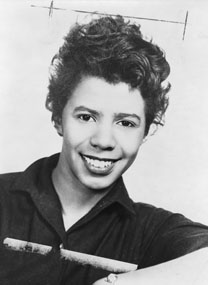Difference between revisions of "Lorraine Hansberry"
(New page: frame|none|This is the sample caption Lorraine Hansberry was born in Chicago. She grew up on the south side of Chicago in the Woodlawn neighborhood. The...) |
(ref) |
||
| Line 1: | Line 1: | ||
| − | [[Image:Lorrainehansberry.jpg|frame|none| | + | [[Image:Lorrainehansberry.jpg|frame|none|Lorraine Hansberry, photo by Alecia Graham]] |
| − | Lorraine Hansberry was born in Chicago. She grew up on the south side of Chicago in the Woodlawn neighborhood. | + | Lorraine Hansberry was born in Chicago. She grew up on the south side of Chicago in the [http://www.encyclopedia.chicagohistory.org/pages/1378.html Woodlawn] neighborhood. |
| − | The family then moved into a white neighborhood. Hansberry attended a predominantly white school while Hansberry's father engaged in a legal battle against a racially restrictive covenant. The legal struggle led to the landmark Supreme Court case of Hansberry v. Lee, 311 U.S. 32 (1940. This experience | + | The family then moved into a white neighborhood. Hansberry attended a predominantly white school while Hansberry's father engaged in a legal battle against a racially restrictive covenant. The legal struggle led to the landmark Supreme Court case of [http://en.wikipedia.org/wiki/Hansberry_v._Lee Hansberry v. Lee], 311 U.S. 32 (1940). This experience inspired her to write her most famous work, [http://en.wikipedia.org/wiki/Raisin_in_the_sun A Raisin in the Sun]. |
| − | [http://www.youtube.com/watch?v=0JUUWLLN03s | + | [http://www.youtube.com/watch?v=0JUUWLLN03s VISUAL DOCUMENT : A Raisin in the Sun, Trailer] |
| − | [http://www.youtube.com/watch?v=iUHoClv9eFA&feature=related | + | [http://www.youtube.com/watch?v=iUHoClv9eFA&feature=related VISUAL DOCUMENT : A Raisin in the Sun, excerpt 1] |
| − | [http://www.youtube.com/watch?v=40HmkyuIO-0 | + | [http://www.youtube.com/watch?v=40HmkyuIO-0 VISUAL DOCUMENT: A Raisin in the Sun, Excerpt 2] |
| − | Hansberry attended the University of Wisconsin-Madison and left in 1950 to pursue her career as a writer in New York City. She worked on the staff of a Black newspaper called Freedom. It was at that time she wrote A Raisin in the Sun | + | Hansberry attended the [http://en.wikipedia.org/wiki/University_of_Wisconsin-Madison University of Wisconsin-Madison] and left in 1950 to pursue her career as a writer in New York City. She worked on the staff of a Black newspaper called [http://en.wikipedia.org/wiki/Freedom_(newspaper) Freedom]. It was at that time she wrote A Raisin in the Sun, the first play written by an African-American woman produced on Broadway. |
| − | At one demonstration, against the exclusion of blacks from university sports, she met Robert Nemiroff, a white Jewish intellectual and | + | At one demonstration, against the exclusion of blacks from university sports, she met Robert Nemiroff, a white Jewish intellectual and married him in 1953. The marriage lasted only a few years. Around 1957, Hansberry joined the [http://en.wikipedia.org/wiki/Daughters_of_bilitis Daughters of Bilitis], the lesbian organization based in San Francisco. |
| − | In May 1957, Hansberry wrote her first letter to the magazine. In her letter, Hansberry displayed a feminist awareness that would grow stronger over the next few years. | + | In May 1957, Hansberry wrote her first letter to the magazine [http://en.wikipedia.org/wiki/The_Ladder_(magazine) The Ladder]. In her letter, Hansberry displayed a feminist awareness that would grow stronger over the next few years. |
| − | [http://outhistory.org/wiki/Lorraine_Hansberry:_To_%22The_Ladder%2C%22_May%2C_August_1957 Letter to the Ladder] | + | [http://outhistory.org/wiki/Lorraine_Hansberry:_To_%22The_Ladder%2C%22_May%2C_August_1957 DOCUMENT: Letter to the Ladder] |
| − | In August of that same year, Hansberry drew a connection between sexism and homophobia: "Homosexual persecution has at its roots not only social ignorance, but a philosophically active anti-feminist dogma." | + | In August of that same year, in another letter, Hansberry drew a connection between sexism and homophobia: "Homosexual persecution has at its roots not only social ignorance, but a philosophically active anti-feminist dogma." |
| − | She died on January 12, 1965, of Pancreatic Cancer, at the age of 34. | + | She died on January 12, 1965, of Pancreatic Cancer, at the age of 34.<ref>For more information, see Pat McKissack, Young, Black, and Determined: A Biography of Lorraine Hansberry (New York: holiday House, 1998)</ref> |
| + | |||
| + | <references/> | ||
Revision as of 16:46, 17 March 2009
Lorraine Hansberry was born in Chicago. She grew up on the south side of Chicago in the Woodlawn neighborhood.
The family then moved into a white neighborhood. Hansberry attended a predominantly white school while Hansberry's father engaged in a legal battle against a racially restrictive covenant. The legal struggle led to the landmark Supreme Court case of Hansberry v. Lee, 311 U.S. 32 (1940). This experience inspired her to write her most famous work, A Raisin in the Sun.
VISUAL DOCUMENT : A Raisin in the Sun, Trailer
VISUAL DOCUMENT : A Raisin in the Sun, excerpt 1
VISUAL DOCUMENT: A Raisin in the Sun, Excerpt 2
Hansberry attended the University of Wisconsin-Madison and left in 1950 to pursue her career as a writer in New York City. She worked on the staff of a Black newspaper called Freedom. It was at that time she wrote A Raisin in the Sun, the first play written by an African-American woman produced on Broadway.
At one demonstration, against the exclusion of blacks from university sports, she met Robert Nemiroff, a white Jewish intellectual and married him in 1953. The marriage lasted only a few years. Around 1957, Hansberry joined the Daughters of Bilitis, the lesbian organization based in San Francisco.
In May 1957, Hansberry wrote her first letter to the magazine The Ladder. In her letter, Hansberry displayed a feminist awareness that would grow stronger over the next few years.
DOCUMENT: Letter to the Ladder
In August of that same year, in another letter, Hansberry drew a connection between sexism and homophobia: "Homosexual persecution has at its roots not only social ignorance, but a philosophically active anti-feminist dogma."
She died on January 12, 1965, of Pancreatic Cancer, at the age of 34.[1]
- ↑ For more information, see Pat McKissack, Young, Black, and Determined: A Biography of Lorraine Hansberry (New York: holiday House, 1998)
